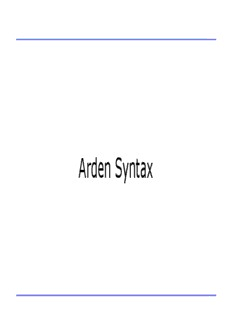Table Of ContentArden Syntax
What is Arden Syntax ?
• … a language used for representing and sharing medical knowledge.
• … used for sharing computerized health knowledge bases across personnel, information
systems, and institutions.
• … organized in modules. Each module referred to as a Medical Logic Module (MLM) contains
sufficient knowledge to make a single decision.
• … an executable format that can be used by clinical decision support systems.
Arden Syntax – Fundamentals I
• In Arden Syntax, medical knowledge is arranged
within Medical Logic Modules (MLMs)
• Each MLM represents sufficient knowledge to make a
single clinical decision
• One or more MLMs are stored within a file that has
the extension “.mlm”
• Each MLM is well organized and structured into
categories and slots with specific content
• An MLM is composed of slots, grouped into the
following four required categories: maintenance,
library, knowledge, and resources
• Categories must appear in the correct order
• Within each category is a set of slots that must
appear in the correct order, too
Arden Syntax – Fundamentals II
• MLMs are working in close contact with their host system. Ways of interaction are:
– Input: By calling an MLM, an input parameter can be committed
– Curly Brace Expressions: So called “curly brace expressions” implement a special kind of
dynamic interaction between MLMs and host systems
– Write Statements: Texts can be written to destinations that are maintained by the host
system
– Output: Analogous to the input parameter, data can be committed from the MLM to the
host system after the execution of the MLM has finished
• In order to start the execution of an MLM, an engine is needed that handles communication with
the host system and can tell which of the MLMs is available
• Ways to start running an MLM:
– MLM call: An MLM is directly called
– Event call: Any MLM that listens to a specific event is executed
Arden Syntax – Fundamentals III
• Data types
• Statements, expressions (assignments, loops, variables, constants, objects)
• Operators
• List operators
• Logical operators
• Comparison operators
• String operators
• Arithmetic operators
• Temporal operators
• Aggregation operators
• Time and object operators
Primary Time
• In addition to its value part, each data value has a primary time part and an degree of
applicability
• Primary time represents the value part’s time of creation or measurement or examination or …
• By default, primary time is null
• Can be accessed using the time operator
2016-03-15T00:00:00 := time of laboratory_result
• Database query results should contain both, the value and the primary time
- Might be the time when a blood test was drawn from the patient
- Might be the time when a medication order was placed
- Which time of a database entry is taken as primary time is left to Arden Syntax implementer
History
• A first draft of the standard was prepared at a meeting at the Arden Homestead, New York, in
1989. Arden Syntax was subsequently adopted as a standard by the American Society for Testing
and Materials (ASTM) as document E 1460, under subcommittee E 31.15 Health Knowledge
Representation.
• 1992: Arden Syntax version 1.0
• 1998: sponsorship moved to HL7 International
(Arden Syntax Work Group)
• 1999: Arden Syntax version 2.0 approved by HL7 and
the American National Standards Institute (ANSI)
• 2014: Arden Syntax version 2.10
History
Version Year Important changes
2.1 2002 new string operators; reserved word “currenttime” returns the system
time
2.5 2005 object capabilities: create and edit objects; XML representation of MLMs
(except logic, action and data slot)
2.6 2007 UNICODE encoding; additional resources category to define text
resources for specific languages; time-of-day and day-of-week data
types; “localized” operator to access texts in specific languages
2.7 2008 enhanced assignment statement; extended “new” operator to allow
easy and flexible object instantiation
2.8 2012 additional operators for list manipulation; operators to manipulate parts
of given date and time values; switch statements; keyword “breakloop”
for aborting a loop; number of editorial corrections
2.9 2013 fuzzification: fuzzy data types and fuzzy sets; adjustment of all
available operators to be able to handle fuzzy data types
2.10 2014 XML representation of whole MLMs (including logic, action and data
slot)
Fuzzy Sets – Background I
• Crisp boundary • Fuzzified boundary
– Defines a gradual transition
– Defines a sharp threshold
– Checking if a given value is greater or
– Checking if a given value is greater or less than the defined fuzzified boundary
less than the defined crisp threshold results in a truth value between 0 and 1
results in either true or false
– Borderline cases are detected
– Borderline cases are not detected
– Weighted results for borderline cases, all
other are as usual
Fuzzy Sets – Example I
• Classical Arden Syntax • Fuzzy Arden Syntax
fever_limit := 38; fever_limit := FUZZY SET (37.5,0), (38,1);
temperature := 37.9; temperature := 37.9;
message := "patient has no fever"; message := "patient has no fever";
IF temperature > fever_limit THEN IF temperature > fever_limit THEN
message := "patient has fever"; message := "patient has fever";
END IF END IF
– Result message: “patient has no fever” – Result message: “patient has fever” (with
applicability 0.8)
– Borderline case is not detected
Description:In Arden Syntax, medical knowledge is arranged within Medical Logic Modules (MLMs). •. Each MLM represents sufficient knowledge to make a.

